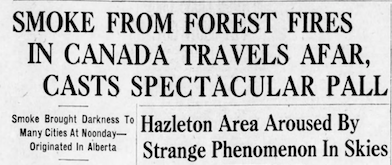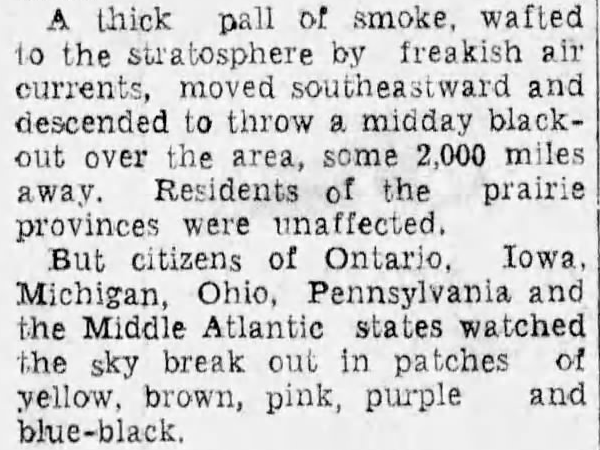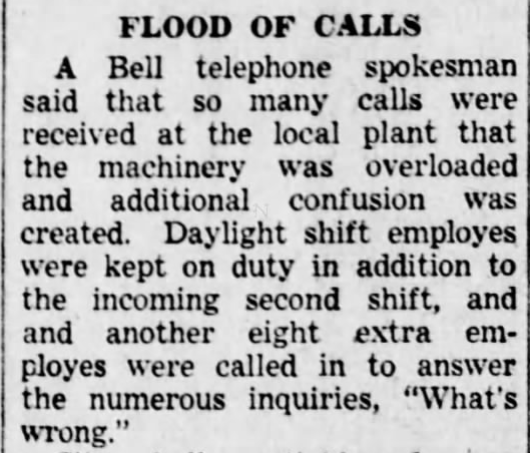In the summer and early fall of 1950, a system of fires in northern Alberta and northeastern British Columbia burned approximately 4 million acres becoming the single largest recorded fire in North America. Known as the Chinchaga fire, it produced smoke that drifted into the upper atmosphere and blanketed portions of Canada and the United States in late September, resulting in the Great Smoke Pall. Thick, black smoke turned the skies dark at midday, leaving some residents wondering if there had been a nuclear attack. The effects of the Great Smoke Pall were felt as far away as Europe.
The Chinchaga fire (also known as the Wisp fire or “Fire 19”) is thought to be human-caused and began near Fort St. John in Alberta, Canada. It was an exceptionally hot and dry spring, and when the fire started on June 1, 1950, it was not highly publicized. Following a policy of ignoring fires in unsettled areas, officials let the fire burn unchecked. The blaze developed into a monstrous conflagration, burning throughout the summer, and expanding as winds and cold fronts moved through.
In September 1950, winds fanned the flames, causing a dramatic fire expansion. Dense smoke rose high in the air where it hit an atmospheric trough and enveloped Ontario, then drifted towards Ohio and America’s east coast. On September 24, people in Ontario reported unusual colors in the sky. By noon, smoke darkened the skies, and streetlights turned on.
Later that afternoon, the smoke arrived along the eastern seaboard. In New York City, pilots landing at LaGuardia Airport reported zero visibility, requiring an instrument landing. At 4:00 p.m., people living in Pennsylvania noticed strange colors in the sky. Within 30 minutes, the skies turned completely dark. The smoke was high enough in the atmosphere, and nobody could smell it, leaving some to wonder if there had been a nuclear attack. Others thought a forecasted total moon eclipse had arrived earlier than expected. People described seeing the moon turn purple. Calls flooded switchboards as many thought the world was coming to an end.
The smoke continued to Western Europe, where smoke particles high in the air made the sun appear blue, leading to more fears of a nuclear attack. In late October 1950, rains and cooler weather finally extinguished the fire. The panic created by the Chinchaga fire led the Canadian Forest Service to adopt new fire suppression methods to prevent another similar occurrence.
To learn more about the Chinchaga fire and the resulting Great Smoke Pall, search Newspapers.com™ today!





Since the last post is closed I am unable to point out how I agree with Dexter’s comments about these papers I forgot about completely! I don’t know why they don’t touch them.
Quote from Dexter :
Do the following newspapers
1. Chicago Sun-Times
2. Detroit News (and Detroit Times)
3. Cleveland Plain Dealer (and Cleveland Press)
4. New York Post
5. Toledo Blade
6. Youngstown Vindicator
7. New Orleans Times-Picayune
8. Dallas Morning News (and Dallas Times Herald)
9. Columbus Dispatch
10. Denver Post (and Rocky Mountain News)
11. Indianapolis News
12. The St Louis Globe Democrat (Defunct)
13. The Las Vegas Review Journal (and The Las Vegas Sun)
14, The Buffalo News (and Courier Journal)
15. Patriot-News (Patriot Union and Harrisburg News)
16, The Oregonian (and Oregon Journal)
17. Los Angeles Herald-Examiner
18. Birmingham News
19. Huntsville Times
20. Syracuse Post-Standard (and Herald-Journal)
21. Tulsa World
22. Wichita Eagle
23. Boston Herald
24. Milwaukee Journal-Sentinel
25. Newark Star-Ledger
26. Houston Chronicle (also Houston Press and Houston Post)
27. Salt Lake Tribune
28, Cincinnati Post
29. San Diego Union-Tribune
30. Washington Post (also Washington Times and Washington Star)
31. San Francisco Examiner
32. Seattle Times and Seattle Post-Intelligencer
Thanks for the suggestions. I will pass these along to our content acquisition team.
Good list.
This is a great and timely article.
One fire from 2021 from western Canadian can be smelled in Montreal, QC.
How about Le Monde or France Soir from Paris, France? (ProQuest)
Fort St. John is in British Columbia, not Alberta. This was pointed out from my Canadian friend who lives in the Toronto area.
It is indeed in BC. I thought ‘that’s wrong’ when reading the article, and verified the location on a map.
Here’s Wikipedia’s introduction:
The City of Fort St. John is a city in northeastern British Columbia, Canada. A member municipality of the Peace River Regional District, the city encompasses a total area of about 22 square kilometres with 18,609 residents at the 2011 census Located at Mile 47, it is one of the largest cities along the Alaska Highway. Originally established in 1794, as a trading post, Fort St. John is the oldest European-established settlement in present-day British Columbia. Fort St. John is served by the Fort St. John Airport.
Most interesting. Memories and history
The Peshtigo fire in Wisconsin, US, burned 1,200’000 acres and estimates of people killed by the fire were between 1500-2500. A priest wrote a first-hand account of the fire that makes remarkably interesting reading. https://digicoll.library.wisc.edu/WIReader/WER2002-1.html
And the Peshtigo fire is, by large, forgotten because it occurred on the same day as the Chicago fire.
So much for ‘climate change’. This happens throughout history. Warming not human caused.
A very interesting report. One small correction: Fort St. John is in the province of British Columbia rather than Alberta.